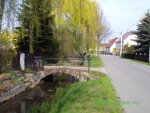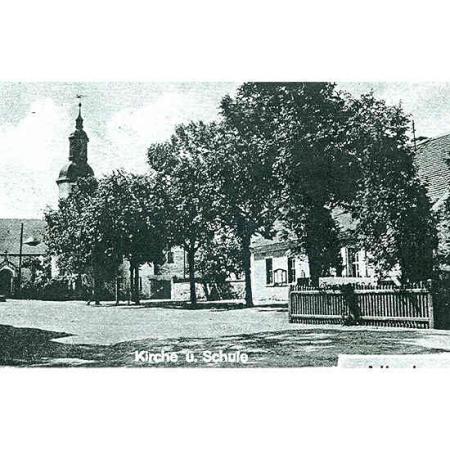Ortsteil Audenhain
Am südlichen Rand der Dübener Heide liegt der OT Audenhain der Gemeinde Mockrehna. Der Ort mit seinen 1052 Einwohnern umfasst eine Fläche von 2047 ha, ist ca. 7 km lang und damit eines der längsten Dörfer Sachsens. Durch den Ort fließt der “Schwarze Graben", der von 88 Brücken überspannt wird und somit dem Ort seinen beiläufigen Namen gibt. Viele Brücken entstanden um die Wende des 19. Jahrhunderts und wurden als Bogenbrücken aus Wildschützer Porphyrgestein errichtet.
Erreichen kann man den Ort mit der Bahn über die Bahnstation Mockrehna und Weiterfahrt mit dem Bus. Mit dem PKW über die B 87 sind die Abfahrten zum 2 km entfernten Audenhain ausgeschildert.
Interessanter ist es jedoch den Ort und seine Umgebung mit dem Fahrrad zu erkunden. Gut ausgebaute Wege laden dazu jederzeit ein.
Entstanden ist dieses lang gestreckte Bauerndorf wahrscheinlich um die Mitte des 12. Jahrhunderts, erstmals erwähnt wurde Audenhain im Jahre 1314 in einem Steuerverzeichnis des damaligen Amtes Torgau. Bis 1902 sprach man vom Ober- u. Unterende, danach war Audenhain in zwei selbstständige Gemeinden, in Ober- u. Niederaudenhain, bis zum Jahre 1950 getrennt. Die ältesten Teile des Ortes sind das ehem. Oberende und der Huxel am östlichen Ende des Dorfes.
Audenhain verfügt auch über zwei Kirchen. So befindet sich im Oberdorf die St. Marien Kirche, im Kern eine spätromanische Saalkirche, die mehrfach umgebaut wurde. Im Unterdorf ist es die St. Petri Kirche, ebenfalls eine spätromanische Saalkirche welche ebenfalls mehrfach umgebaut wurde und als Hauptkirche bezeichnet wird.
Unmittelbar in Kirchnähe befindet sich das ev. Pfarramt. Das Gebäude wurde Ende des 15. Jahrhunderts errichtet und ist damit eines der ältesten Häuser in Audenhain. Die Reformation, die 1525 auch hier einzog, führte auch Luther in dieses Haus.
Die Landwirtschaft prägte seit jeher das Bild des Dorfes. So gab es bis um 1927 sechs Windmühlen und zwei Wassermühlen im Ort, wovon heute nur noch Reste von der 1628 erstmals erwähnten Wassermühle Große und die noch funktionsfähige 1751 errichtete Paltrockmühle der Fam. Ebbecke vorhanden sind. Die Paltrockmühle befindet sich am östlichen Ende des Dorfes im OT Heide am Fuße des Krähenberges. Es ist die einzige noch funktionsfähige Mühle dieser Art im Landkreis Torgau / Oschatz. Besichtigen kann man die Paltrockmühle alljährlich am Pfingstmontag zum Deutschen Mühlentag oder auf Anmeldung über Tel. (034244) 50854.
Sehenswert sind aber nicht nur die vielen Brücken und die Mühle, sondern auch die z. T. noch vollständig erhaltenen 3-Seitenhöfe, mit ihren großen und gepflegten Vorgärten und Obstwiesen.
Zu Ehren der Brücken findet jedes Jahr am ersten Augustwochenende ein Heimat- u. Brückenfest statt. Aber nicht nur die Brücken und die Mühle sind einen Besuch wert, auch die Heimatstube in der 1998 geschlossene Schule lädt zu einem Besuch ein. Hier kümmert sich Harry Liebmann um viele altvertraute Gegenstände aus dem einstigen dörflichen Leben und die Geschichte des Ortes. Besichtigen kann man die Heimatstube auf Anmeldung über Tel. (034244) 50670.
Zusätzlich zur Heimatstube gibt es in Audenhain auch ein Feuerwehrmuseum. Hier hat Manfred Haberkorn alles gesammelt, was mit Feuerwehr und Brandschutz zu tun hat. Besichtigungen sind auch hier nach Vereinbarung über Telefon: (034244) 51039 möglich.
Audenhain hat auch ein reges Vereinsleben. Der Heimat- u. Kulturverein führt jährlich das erwähnte Brückenfest u. Faschingsveranstaltungen durch, der Sportverein besitzt einen eigenen Tennisplatz und eine Mehrzweckhalle, in welcher 92 Mitglieder aktiv sind und jedes Jahr am 01. Mai wird von diesem Verein das Baumfest an „Meyers Gasthof" durchgeführt. Des weiteren bereichert der Rassegeflügelzuchtverein mit Ausstellungen und dem Wein- u. Winzerfest das kulturelle Leben im Dorf. Auch der Rassekaninchenverein, die Feuerwehr mit Spielmannszug, der Karten- u. Spielverein sowie die Schützengilde tragen mit dazu bei, dass im Ort keine Langeweile aufkommt.
In Audenhain können sie auch einkaufen, einkehren und übernachten. Unser Ort hat mit einem Bäcker, einem Frisör, einem Quelle-Shop, einem Blumenladen, einem Getränkeshop, einer Verkaufsstelle mit einem Sortiment fürs Bauen, Haus Hof und Garten sowie mit „Meyers Gasthof' mit Pension, welcher von Montag bis Freitag geöffnet hat, eine noch einigermaßen gute Infrastruktur.
Über einen Besuch in Audenhain würden wir uns freuen.
Text: Harry Liebmann
Englische Version:
AudenhainBruecke2At the southern edge of the "Duebener Heide" (heath-land) you will find the district of Audenhain, one of nine such governmental districts that belong to the larger community of Mockrehna. The village of Audenhain with its 1052 inhabitants comprises an area of 2047 ha (5058.14 acres), is about 7 km (4.35 miles) long and thus one of the longest villages in Saxony. The "Schwarze Graben" (Black Stream) a natural approximately 2-meter wide channel, meanders through the village and is spanned by 88 bridges. Because of this, Audenhain has its nickname, "Saxony's Little Venice".
Many of these picturesque arch bridges date back to the turn of the 20th century, constructed by using a very hard dark stone (porphyry) quarried at Wildschuetz.
You can easily reach Audenhain from the Mockrehna rail station by bus, bike or car or a hearty 2 km (1.24 mile) walk. On the map you will find Audenhain lies southeast of Mockrehna. From the station first take the B87, then the S16 (Schildauer Strasse) directly to Audenhain. The route is well marked with signposts. Many cyclists enjoy exploring the village and surrounding area using the well-maintained bike paths.
AudenhainBruecke3Audenhain was first mentioned in a tax register of Torgau in 1314, and it is believed this long-stretched, early two-part village had its birth in mid 12th century. Up until 1902 two names were used for the village: Audenhain Upper End and Audenhain Lower End. Later and until 1950, still existing as two independent communities, the names Upper Audenhain and Lower Audenhain came into use. Today we find Upper Audenhain (the higher southwest end) and Lower Audenhain (the lower northeast end comprised of three parts - the Central Community, Huxel and Heide neighbourhoods). Upper Audenhain and Huxel retain more of the oldest structures and landmarks of the village.
Audenhain has two Protestant churches. Both are structures rich in late Romanesque hall church detail. And both show evidence of the repeated reconstructions through the decades. The St. Marien Church is located in Upper Audenhain (South-West). In Lower Audenhain (North-East) there is the St. Petri Church, referred to as the "main church".
Very close to the St. Petri Church there is Audenhain's Protestant rectory. This building was erected at the end of the 15th century and thus it is one of the oldest buildings in Audenhain.
Martin Luther spent some time in this building in 1525, during the Protestant Reformation.
Audenhain has been a scene of agricultural activity from its beginning. Until 1927 there had been as many as six windmills and two watermills. In those days, these mills were the power engines that provided the work that was later assigned to fossil fuel motors. Today only two of these mills remain. One non-working watermill owned by the Grosse-family (mentioned for the first time in 1628 records) and the Ebbeckes' "Paltrock" windmill which is still in working order and available for visits. The "Paltrock" windmill is situated at the eastern end of the village in the district Heide at the foot of the hill "Krähenberg". This is the only functioning mill of this kind in the district Torgau/Oschatz. You can pay a visit to the "Paltrock" windmill every year on Whit Monday (Pentecost Monday or "Pfingstmontag", a local holiday), or contact (034244) 50854 for other opportunities. A working windmill is a surprise for the first-time visitor especially for those with technical interests.
Not only will the visitor find the many bridges and the mill interesting, but also the exquisitely preserved so-called "three-sided farms" (built along three sides of a square or rectangle) with their large and well-kept front-yards and orchards. In celebration of the bridges and homes a feast is held every year during the first weekend in August.
"Heimatstube", a museum housed in an old school building since 1998, contains many interesting artefacts of local significance. Harry Liebmann is responsible for the many old rural items and historic records of this village. He welcomes you to the "Heimatstube". Please contact (034244) 50670 for tour arrangements.
The Audenhain Fire Department Museum displays many old, some very rare, fire fighting and fire prevention artefacts. Manfred Haberkorn manages the collection and arranges guided tours.
Please phone (034244) 51039.
AudenhainBruecke1Audenhain has many social clubs and events. The Home and Culture Club holds the August Bridge and Home Feast and also various carnival events. The Sports Club has its own tennis court and a multifunctional gym, in which 92 members are currently active, and each May 1st holds a Tree Feast at the "Meyers Gasthof" inn. The Poultry Breeding Association holds exhibitions, and hosts the wine and winegrower's feast. They also provide, along with the Fire Department, marching bands for local parades. The Play Card and Playing Club, as well as the Gun Club, add to the social enrichment.
In Audenhain you can go shopping, enjoy a pub, and spend the night. It makes a great holiday destination! Our village meets all your holiday needs with a bakery, a hairdresser, a "Quelle" store, a flower shop and a beverage store, furthermore a market offering special items for the DIY interested in home-improvement and gardening; as well as the "Meyers Gasthof" guest house, which is open from Monday to Friday.
Make us, and yourself, very happy by visiting Audenhain.
German text: Harry Liebmann
Translated: Dr. Ursula Roscher, Audenhain
Adapted: Jim Redic, Atlanta (Georgia, USA)


